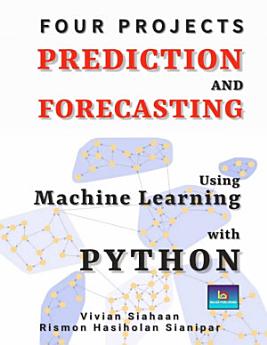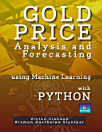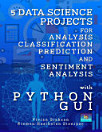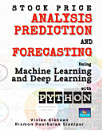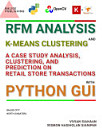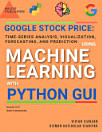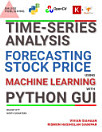FOUR PROJECTS: PREDICTION AND FORECASTING USING MACHINE LEARNING WITH PYTHON
About this ebook
The challenge of this project is to accurately predict the future adjusted closing price of Gold ETF across a given period of time in the future. The problem is a regression problem, because the output value which is the adjusted closing price in this project is continuous value.
Data for this study is collected from November 18th 2011 to January 1st 2019 from various sources. The data has 1718 rows in total and 80 columns in total. Data for attributes, such as Oil Price, Standard and Poor’s (S&P) 500 index, Dow Jones Index US Bond rates (10 years), Euro USD exchange rates, prices of precious metals Silver and Platinum and other metals such as Palladium and Rhodium, prices of US Dollar Index, Eldorado Gold Corporation and Gold Miners ETF were gathered.
The dataset has 1718 rows in total and 80 columns in total. Data for attributes, such as Oil Price, Standard and Poor’s (S&P) 500 index, Dow Jones Index US Bond rates (10 years), Euro USD exchange rates, prices of precious metals Silver and Platinum and other metals such as Palladium and Rhodium, prices of US Dollar Index, Eldorado Gold Corporation and Gold Miners ETF were gathered.
To perform forecasting based on regression adjusted closing price of gold, you will use: Linear Regression, Random Forest regression, Decision Tree regression, Support Vector Machine regression, Naïve Bayes regression, K-Nearest Neighbor regression, Adaboost regression, Gradient Boosting regression, Extreme Gradient Boosting regression, Light Gradient Boosting regression, Catboost regression, and MLP regression.
The machine learning models used predict gold daily returns as target variable are K-Nearest Neighbor classifier, Random Forest classifier, Naive Bayes classifier, Logistic Regression classifier, Decision Tree classifier, Support Vector Machine classifier, LGBM classifier, Gradient Boosting classifier, XGB classifier, MLP classifier, and Extra Trees classifier. Finally, you will plot boundary decision, distribution of features, feature importance, predicted values versus true values, confusion matrix, learning curve, performance of the model, and scalability of the model.
PROJECT 2: WIND POWER ANALYSIS AND FORECASTING USING MACHINE LEARNING WITH PYTHON
Renewable energy remains one of the most important topics for a sustainable future. Wind, being a perennial source of power, could be utilized to satisfy our power requirements. With the rise of wind farms, wind power forecasting would prove to be quite useful. It contains various weather, turbine and rotor features. Data has been recorded from January 2018 till March 2020. Readings have been recorded at a 10-minute interval. A longterm wind forecasting technique is thus required.
The attributes in the dataset are as follows: ActivePower, AmbientTemperature, BearingShaftTemperature, Blade1PitchAngle, Blade2PitchAngle, Blade3PitchAngle, ControlBoxTemperature, GearboxBearingTemperature, GearboxOilTemperature, GeneratorRP, GeneratorWinding1Temperature, GeneratorWinding2Temperature, HubTemperature, MainBoxTemperature, NacellePosition, ReactivePower, RotorRPM, TurbineStatus, WTG, WindDirection, and WindSpeed.
To perform forecasting based on regression active power, you will use: Linear Regression, Random Forest regression, Decision Tree regression, Support Vector Machine regression, Naïve Bayes regression, K-Nearest Neighbor regression, Adaboost regression, Gradient Boosting regression, Extreme Gradient Boosting regression, Light Gradient Boosting regression, Catboost regression, and MLP regression. To perform clustering, you will use K-Means algorithm.
The machine learning models used predict categorized active power as target variable are K-Nearest Neighbor classifier, Random Forest classifier, Naive Bayes classifier, Logistic Regression classifier, Decision Tree classifier, Support Vector Machine classifier, LGBM classifier, Gradient Boosting classifier, XGB classifier, and MLP classifier. Finally, you will plot boundary decision, distribution of features, feature importance, cross validation score, and predicted values versus true values, confusion matrix, learning curve, performance of the model, scalability of the model, training loss, and training accuracy.
PROJECT 3: MACHINE LEARNING FOR CONCRETE COMPRESSIVE STRENGTH ANALYSIS AND PREDICTION WITH PYTHON
Concrete is the most important material in civil engineering. The concrete compressive strength is a highly nonlinear function of age and ingredients. These ingredients include cement, blast furnace slag, fly ash, water, superplasticizer, coarse aggregate, and fine aggregate. The actual concrete compressive strength (MPa) for a given mixture under a specific age (days) was determined from laboratory. This dataset is in raw form (not scaled). There are 1030 observations, 9 attributes, 8 quantitative input variables, and 1 quantitative output variable in dataset.
The attributes in the dataset are as follows: Cement (component 1); Blast Furnace Slag (component 2); Fly Ash (component 3); Water (component 4); Superplasticizer (component 5); Coarse Aggregate; Fine Aggregate (component 7); Age; and Concrete compressive strength.
To perform regression on concrete compressive strength, you will use: Linear Regression, Random Forest regression, Decision Tree regression, Support Vector Machine regression, Naïve Bayes regression, K-Nearest Neighbor regression, Adaboost regression, Gradient Boosting regression, Extreme Gradient Boosting regression, Light Gradient Boosting regression, Catboost regression, and MLP regression. To perform clustering, you will use K-Means algorithm.
The machine learning models used predict clusters as target variable are K-Nearest Neighbor classifier, Random Forest classifier, Naive Bayes classifier, Logistic Regression classifier, Decision Tree classifier, Support Vector Machine classifier, LGBM classifier, Gradient Boosting classifier, XGB classifier, and MLP classifier. Finally, you will plot boundary decision, distribution of features, feature importance, cross validation score, and predicted values versus true values, confusion matrix, learning curve, performance of the model, scalability of the model, training loss, and training accuracy.
PROJECT 4: DATA SCIENCE FOR SALES ANALYSIS, FORECASTING, CLUSTERING, AND PREDICTION WITH PYTHON
The dataset used in this project is from Walmart which is a renowned retail corporation that operates a chain of hypermarkets. Walmart has provided a data combining of 45 stores including store information and monthly sales. The data is provided on weekly basis. Walmart tries to find the impact of holidays on the sales of store. For which it has included four holidays’ weeks into the dataset which are Christmas, Thanksgiving, Super bowl, Labor Day. In this project, you are going to analyze, forecast weekly sales, perform clustering, and predict the resulting clusters.
The dataset covers sales from 2010-02-05 to 2012-11-01. Following are the attributes in the dataset: Store - the store number; Date - the week of sales; Weekly_Sales - sales for the given store; Holiday_Flag - whether the week is a special holiday week 1 – Holiday week 0 – Non-holiday week; Temperature - Temperature on the day of sale; Fuel_Price - Cost of fuel in the region; CPI – Prevailing consumer price index; and Unemployment - Prevailing unemployment rate.
To perform regression on weekly sales, you will use: Linear Regression, Random Forest regression, Decision Tree regression, Support Vector Machine regression, Naïve Bayes regression, K-Nearest Neighbor regression, Adaboost regression, Gradient Boosting regression, Extreme Gradient Boosting regression, Light Gradient Boosting regression, Catboost regression, and MLP regression. To perform clustering, you will use K-Means algorithm.
The machine learning models used predict clusters as target variable are K-Nearest Neighbor classifier, Random Forest classifier, Naive Bayes classifier, Logistic Regression classifier, Decision Tree classifier, Support Vector Machine classifier, LGBM classifier, Gradient Boosting classifier, XGB classifier, and MLP classifier. Finally, you will plot boundary decision, distribution of features, feature importance, cross validation score, and predicted values versus true values, confusion matrix, learning curve, performance of the model, scalability of the model, training loss, and training accuracy.
Ratings and reviews
- Flag inappropriate
About the author
Vivian Siahaan is a fast-learner who likes to do new things. She was born, raised in Hinalang Bagasan, Balige, on the banks of Lake Toba, and completed high school education from SMAN 1 Balige. She started herself learning Java, Android, JavaScript, CSS, C ++, Python, R, Visual Basic, Visual C #, MATLAB, Mathematica, PHP, JSP, MySQL, SQL Server, Oracle, Access, and other programming languages. She studied programming from scratch, starting with the most basic syntax and logic, by building several simple and applicable GUI applications. Animation and games are fields of programming that are interests that she always wants to develop. Besides studying mathematical logic and programming, the author also has the pleasure of reading novels. Vivian Siahaan has written dozens of ebooks that have been published on Sparta Publisher: Data Structure with Java; Java Programming: Cookbook; C ++ Programming: Cookbook; C Programming For High Schools / Vocational Schools and Students; Java Programming for SMA / SMK; Java Tutorial: GUI, Graphics and Animation; Visual Basic Programming: From A to Z; Java Programming for Animation and Games; C # Programming for SMA / SMK and Students; MATLAB For Students and Researchers; Graphics in JavaScript: Quick Learning Series; JavaScript Image Processing Methods: From A to Z; Java GUI Case Study: AWT & Swing; Basic CSS and JavaScript; PHP / MySQL Programming: Cookbook; Visual Basic: Cookbook; C ++ Programming for High Schools / Vocational Schools and Students; Concepts and Practices of C ++; PHP / MySQL For Students; C # Programming: From A to Z; Visual Basic for SMA / SMK and Students; C # .NET and SQL Server for High School / Vocational School and Students. At the ANDI Yogyakarta publisher, Vivian Siahaan also wrote a number of books including: Python Programming Theory and Practice; Python GUI Programming; Python GUI and Database; Build From Zero School Database Management System In Python / MySQL; Database Management System in Python / MySQL; Python / MySQL For Management Systems of Criminal Track Record Database; Java / MySQL For Management Systems of Criminal Track Records Database; Database and Cryptography Using Java / MySQL; Build From Zero School Database Management System With Java / MySQL.
Rismon Hasiholan Sianipar was born in Pematang Siantar, in 1994. After graduating from SMAN 3 Pematang Siantar 3, the writer traveled to the city of Jogjakarta. In 1998 and 2001 the author completed his Bachelor of Engineering (S.T) and Master of Engineering (M.T) education in the Electrical Engineering of Gadjah Mada University, under the guidance of Prof. Dr. Adhi Soesanto and Prof. Dr. Thomas Sri Widodo, focusing on research on non-stationary signals by analyzing their energy using time-frequency maps. Because of its non-stationary nature, the distribution of signal energy becomes very dynamic on a time-frequency map. By mapping the distribution of energy in the time-frequency field using discrete wavelet transformations, one can design non-linear filters so that they can analyze the pattern of the data contained in it. In 2003, the author received a Monbukagakusho scholarship from the Japanese Government. In 2005 and 2008, he completed his Master of Engineering (M.Eng) and Doctor of Engineering (Dr.Eng) education at Yamaguchi University, under the guidance of Prof. Dr. Hidetoshi Miike. Both the master's thesis and his doctoral thesis, R.H. Sianipar combines SR-FHN (Stochastic Resonance Fitzhugh-Nagumo) filter strength with cryptosystem ECC (elliptic curve cryptography) 4096-bit both to suppress noise in digital images and digital video and maintain its authenticity. The results of this study have been documented in international scientific journals and officially patented in Japan. One of the patents was published in Japan with a registration number 2008-009549. He is active in collaborating with several universities and research institutions in Japan, particularly in the fields of cryptography, cryptanalysis and audio / image / video digital forensics. R.H. Sianipar also has experience in conducting code-breaking methods (cryptanalysis) on a number of intelligence data that are the object of research studies in Japan. R.H. Sianipar has a number of Japanese patents, and has written a number of national / international scientific articles, and dozens of national books. R.H. Sianipar has also participated in a number of workshops related to cryptography, cryptanalysis, digital watermarking, and digital forensics. In a number of workshops, R.H. Sianipar helps Prof. Hidetoshi Miike to create applications related to digital image / video processing, steganography, cryptography, watermarking, non-linear screening, intelligent descriptor-based computer vision, and others, which are used as training materials. Field of interest in the study of R.H. Sianipar is multimedia security, signal processing / digital image / video, cryptography, digital communication, digital forensics, and data compression / coding. Until now, R.H. Sianipar continues to develop applications related to analysis of signal, image, and digital video, both for research purposes and for commercial purposes based on the Python programming language, MATLAB, C ++, C, VB.NET, C # .NET, R, and Java.
